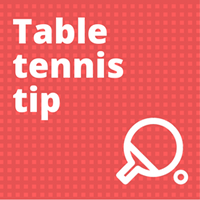Here’s a familiar scenario. Two players warm-up doing forehand drives cross court. And then they do more forehand drives. And then some more.
Then they may do some random play varying spin and placement, but with the real purpose in mind.
At some point, one of the player’s gets slightly bored and says ‘shall we play a match?’ And that’s it, practice over!
Neither player has practiced what they need to, but they have played a lot of forehand drives (this is often why people are so good at doing forehand drives because they practice it more than any other shot!).
I have to confess that I have done this routine more times than I care to remember. But it seems such a wasted opportunity. There are so many areas of my game I need to improve. And with coaching commitments and family life, I just don’t have as much time to practice as I would like. So when I do practice I need to make more of it.
Some players are fortunate to attend clubs with well structured practice sessions, but the vast majority of players attend sessions with no structure at all. There’s nothing inherently wrong with this, it just means there’s more emphasis on the players themselves to create the structure.
So here’s a very simple way you can structure your practice session.
Think of three areas of your game you want to improve, e.g. third ball attack, blocking, returning long serves. Your partner thinks of three things to work on too.
Now set a timer for 5 mins. Use your mobile phone or anything else which will sound an alarm when the five minutes is up.
For the first five minutes you work on something on your list, e.g. third ball attack. Your partner becomes the feeder, returning the ball how you have instructed, so you can practice your 3rd ball attacks again and again.
After 5 minutes you switch roles. Your partner chooses something from their list and you become the feeder, helping them practice what they need to.
Repeat two more times each.
After 30 minutes, you will have both worked on three areas of your game which needs improvement. And you’ll probably find the exercises your partner has chosen will often benefit you too. If your partner wants to practice their blocking, this means you get to practice your topspins.
Having the timer, and sticking to it, is important, as you both get equal practice time. You don’t have to feel guilty about the other player being the feeder, because after 5 minutes when the alarm sounds, it’s their turn.
I’ve been doing this in my practice sessions quite a lot recently and have found it a much better use of my limited practice time. It has allowed me to work on areas of my game, which I tend to neglect and therefore never improve. So if you also have limited practice time or attend sessions with no structure, try this simple exercise. It is far better than endless forehand to forehand drives!
More training drills
If you would like more training drill ideas, I recommend you join Tom’s TT Academy. In my online academy, you will get access to my training drill library. Every training drill includes a video demonstration, plus technical tips and ideas to make the drill easier or harder.
When you join my academy, you will also get access to a wide range of coaching content, including:
- in-depth courses
- video analysis
- fitness videos
- robot training videos
- member discussions
- skill challenges
- and lot’s more!
You can access all this content for less than £1 per week. New content is added regularly. Join hundreds of table tennis players around the world today at tomsttacademy.com
Get more table tennis tips
Sign up for my popular table tennis newsletter and I’ll send you table tennis tips, tactics and training drills to help you improve and win more points. Subscribe

